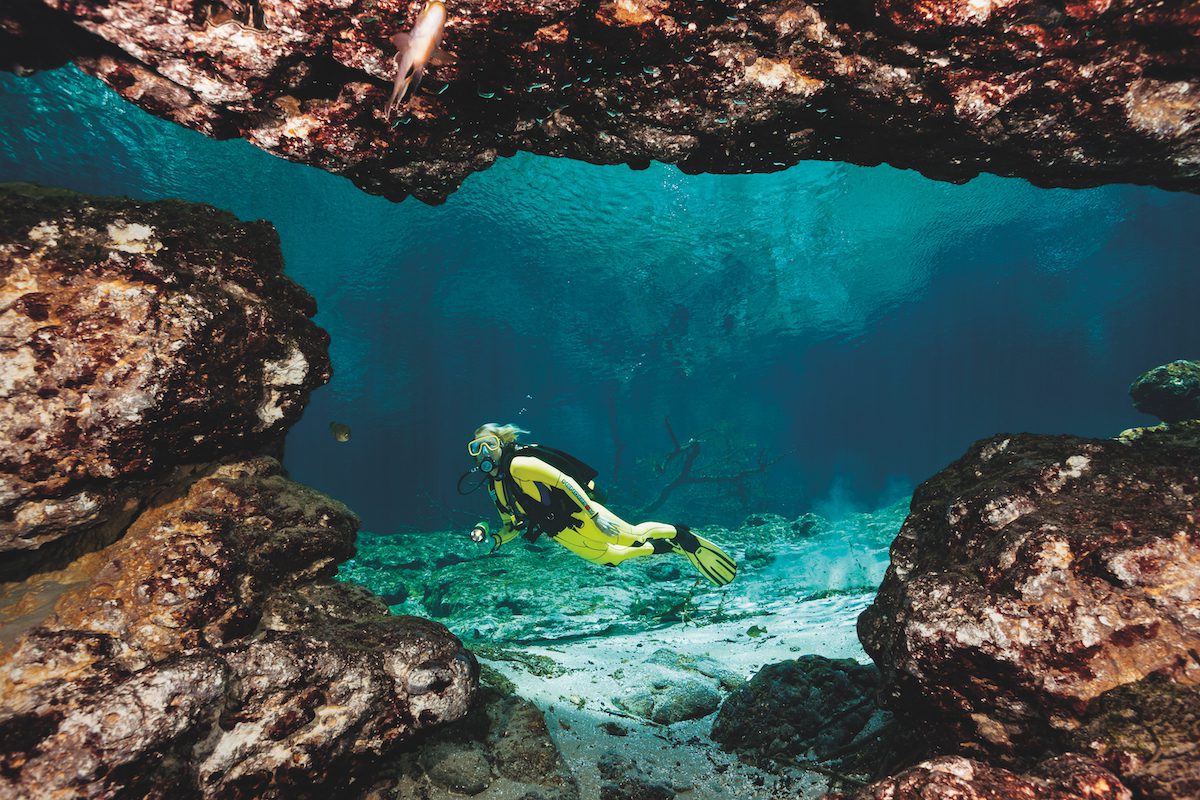Photographs by Walt Stearns
A faint but growing glimmer of light in the passage ahead signals the end of our dive. We exit a realm of eternal darkness into a circular basin of clear water. Above, the surface is as smooth and transparent as plate glass, and the pool’s surrounding tree line is clearly discernable. The transition from shadows into the illuminated pool borders on the surreal.
This is why I never tire of Florida springs diving. And on that late Fall day, the entire basin was ours. I’m always amused when people stop diving Florida springs when the weather changes, because the water temperatures in these sparkling pools are always the same 72-74 degrees F. It is this consistency and clarity that are the essence of diving Florida’s fountains of youth.
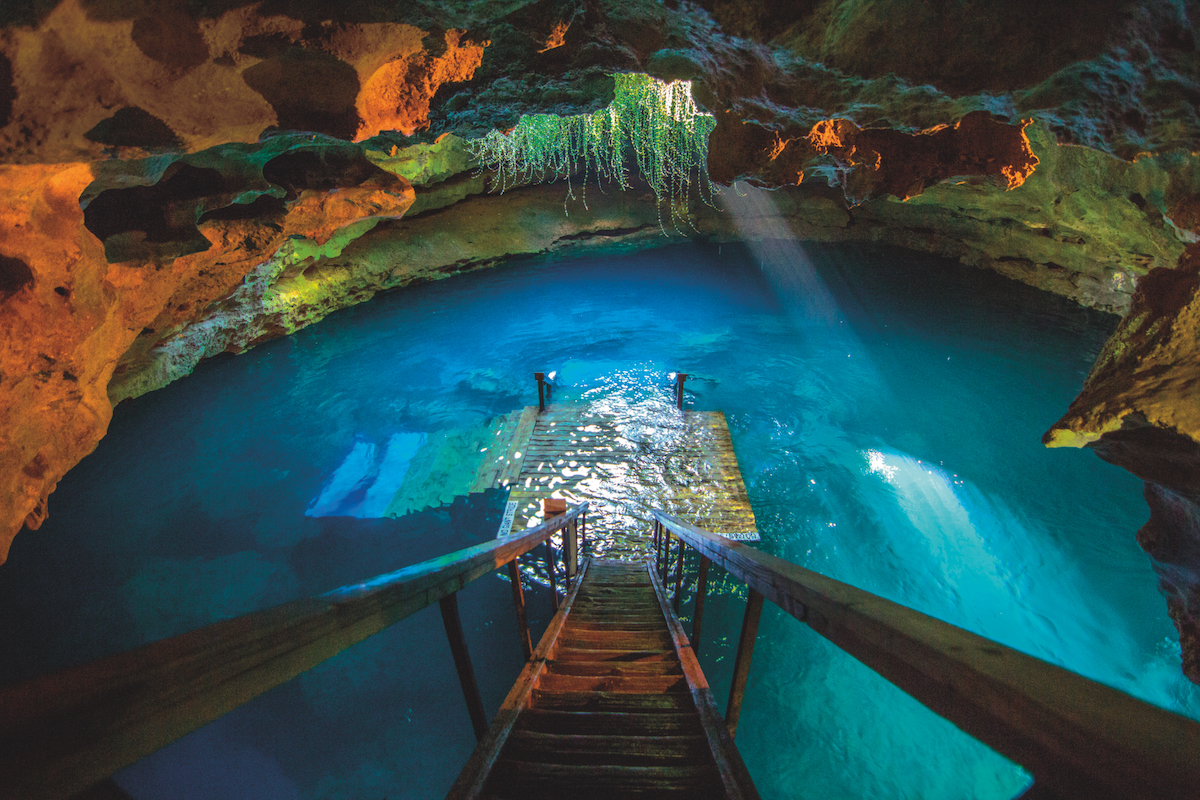
Florida's Springs of Phenomenal Magnitude
More than 700 springs well up across the northern end of the Florida peninsula. While more than half amount to little more than a trickle, 33 are of first magnitude, with another 191 in the second magnitude. A first magnitude spring releases water at a rate of 100 cubic feet or more per second — a veritable cascade.
Florida's Silver Springs is ranked among the world’s largest, disgorging some 500 million gallons of water a day. Comparatively, Devil’s Eye discharges about 46 million gallons a day, making it ‘middle of the road’ or a second magnitude spring. These flowing waters emerge from the state's limestone substrate, which absorbs rainwater like a giant sponge, and is riddled with crevices and fissures that channel flowing waters into underground rivers.
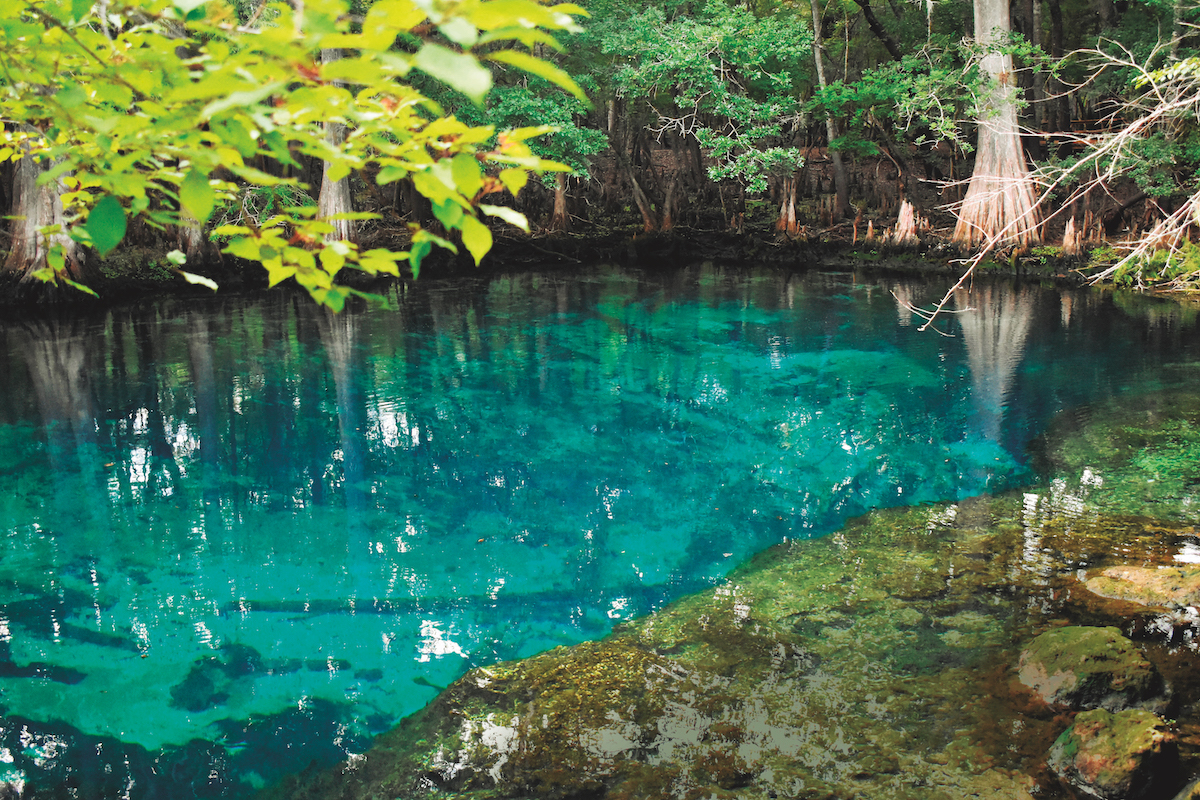
Ginnie Springs – Florida Springs Diving Heaven
This privately-owned, commercialized park north of Gainesville off Interstate 75 and US 27 plays host to one of the most-eclectic gathering of divers this side of the globe. Visit in summer and the park may feel more like a zoo – from paddlers with mask and snorkel to serious techies suited up in doubles to fully closed rebreather systems – giving credence to the expression ‘what separates the men from the boys is the size of their toys’.
The attraction for divers is clear water, consistent conditions and vast underground possibilities. Lying beyond the sunlit world is a cave diver’s nirvana. Here, a pair of narrow submerged entrances provide the technical diving community a highly coveted doorway to a massive subterranean river system suitable for both training and exploration. Eons of water movement have sculpted a winding warren of tunnels. To date, more than 30,000 feet of this expansive network of submarine caves has been explored and mapped.
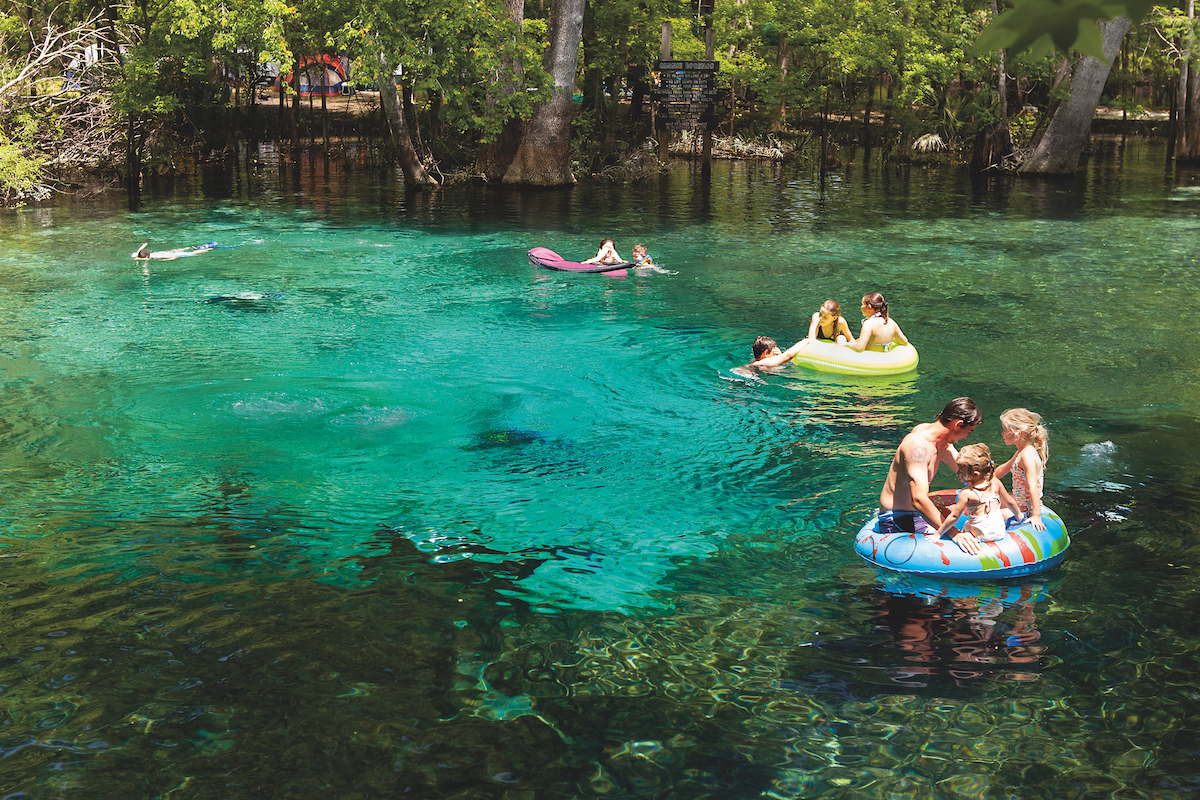
Suwannee River Basin’s World Without Sun
The Suwannee River Basin is the epicenter for diving Florida's caves. In fact, most of the world’s cave divers learn here. Whenever I visit Devil’s Eye and Ear, I also like to include a jaunt through the cave systems of the Wes Skiles Peacock Springs State Park. Prior to 2010, the park was known as Peacock Springs State Park. Shortly after Wes passed, the park was renamed to commemorate the life work of Florida’s famed cave diver and explorer.
“Dedicated almost exclusively to cave diving, and for good reason, the Peacock system is one of the region’s most-expansive submerged cave systems, with a honeycomb network of passages that stretch for thousands of feet.”
For most cavers, the primary entry points into this system are Orange Grove Sink or the Peacock 1 basin. These entry points provide steps down to the water and systems with permanent guidelines. Water movement in Peacock 1 is much slower than Devil’s Ear, making it easier to penetrate the deep regions of the system. Upstream from the spring entrance, the lower portion of the system is crisscrossed with numerous tunnels. My personal favorite for photography is Peanut Tunnel (name for its narrow peanut-shape passage). I also like that it’s just 300 feet from the exit.
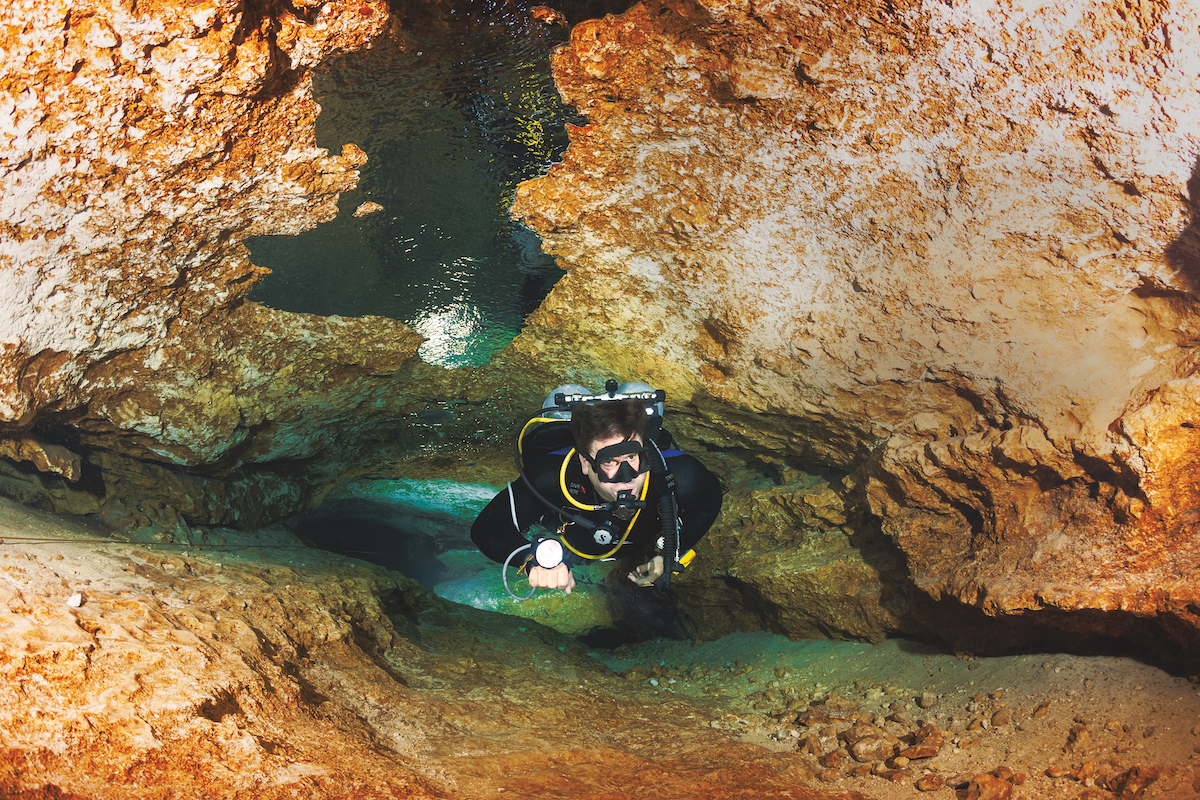
Diving Florida's Caverns and Clear-Water Basins
Not into cave diving? No problem! Sites like Ginnie’s main spring basin offer a different experience when going Florida springs diving The 12ft-deep, 90-foot circular pool is a popular site for open water checkouts, along with cave and cavern courses which take place inside the cavern known as the Ballroom. Not to be confused with cave diving, cavern divers stay within constant visual contact of the cave’s entrance.
As cavern dives go, the Ballroom is quite safe, open to anyone with an open-water rating and a dive light. Angling down 45 degrees to a depth of 50ft, the large central chamber terminates at a large welded grate that prevents divers from entering the maze-like cave system beyond.
Several other springs off US Highway 27 between High Springs and Ocala are also worthy of a visit. Just up the road from Ginnie are Blue and Poe Springs. Both feature clear basins with white sand bottoms for snorkeling. Following US 27 south to Williston leads to Devil’s Den and Blue Grotto, followed by Paradise Spring in Ocala.
All three spring/cavern combos are open to all certification levels, but Devil’s Den stands alone for its visually stunning impact.
The name Devil’s Den came from the smoke-like appearance caused by the warm water spring mixing with cold morning air. The dive itself begins inside a 100-foot diameter dry cave. The eye-catcher inside this amphitheater-shaped cavern is the 40-foot diameter hole in the ceiling, which lights the circular pool below. Passages into the Den’s two underwater cave systems are blocked off, leaving plenty of swim-throughs to loop through.
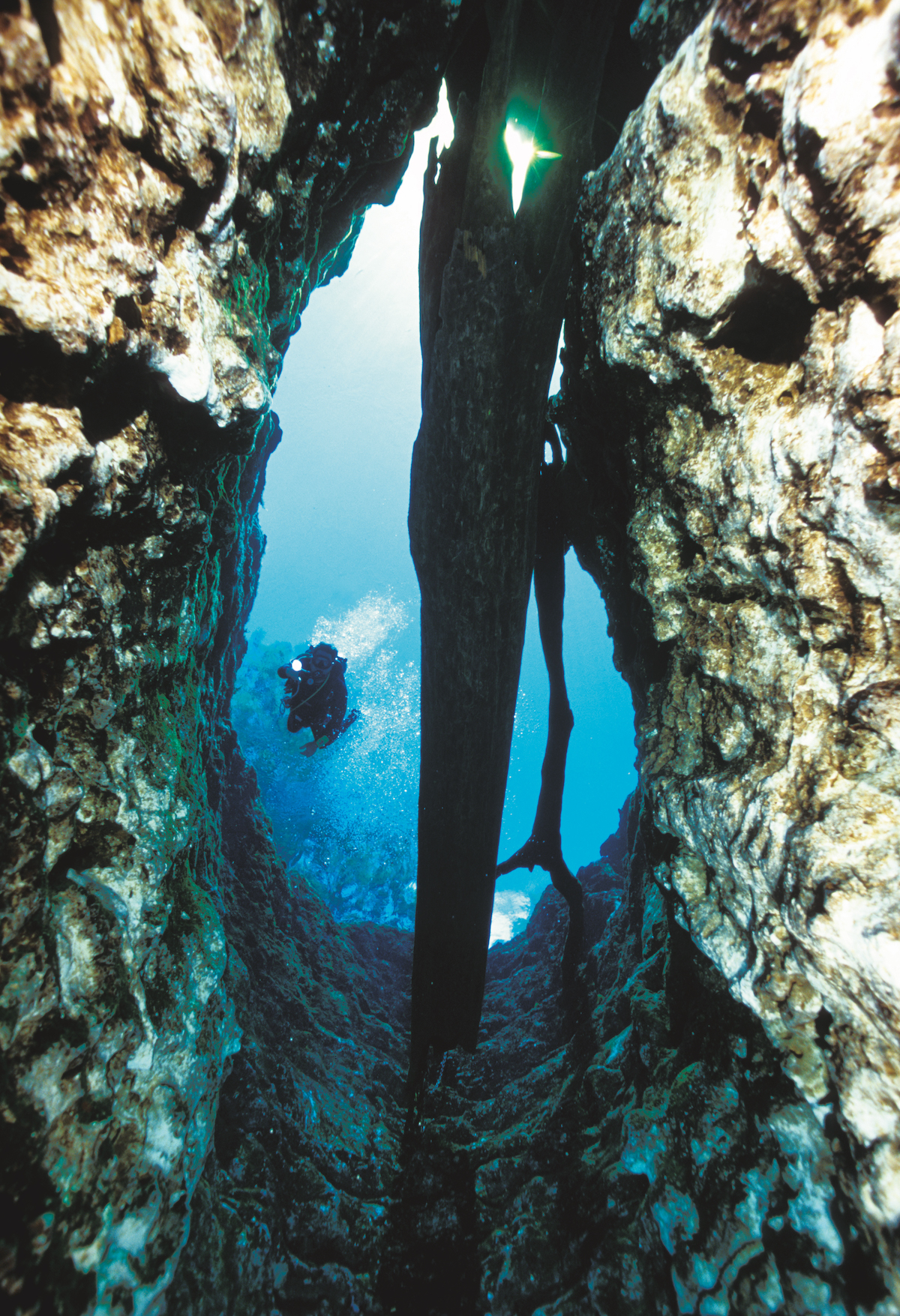
Manatee Springs – A Serene Treat
Located just outside of the small west Florida town of Chiefland, Manatee Springs is the centerpiece of a state park. This spot is not promoted to entice divers to put a few more miles on the odometer. This site offers two very different venues for Florida springs diving: a large spring basin and a neighboring sinkhole. The park's namesake spring basin forms a pool some 80 feet across and about 25ft deep. There is a narrow but obvious cave opening but there’s little danger of straying into the darkness beyond, as the outflow is quite strong. Adventurous types may be able to pull themselves a few feet down into the cave mouth, but this is not a good idea as the buffeting currents could lead to a nasty head bump should you lose your grip.
Because the upstream sinkhole draws particulate into the cave's water flow, Manatee doesn't deliver quite the bottled-water clarity of venues, such as Ginnie Springs. Instead, it's more the equivalent of an afternoon summer haze in the mountains, giving substance to the sunbeams that filter down from above, while softening but not obscuring the far walls of the pool.
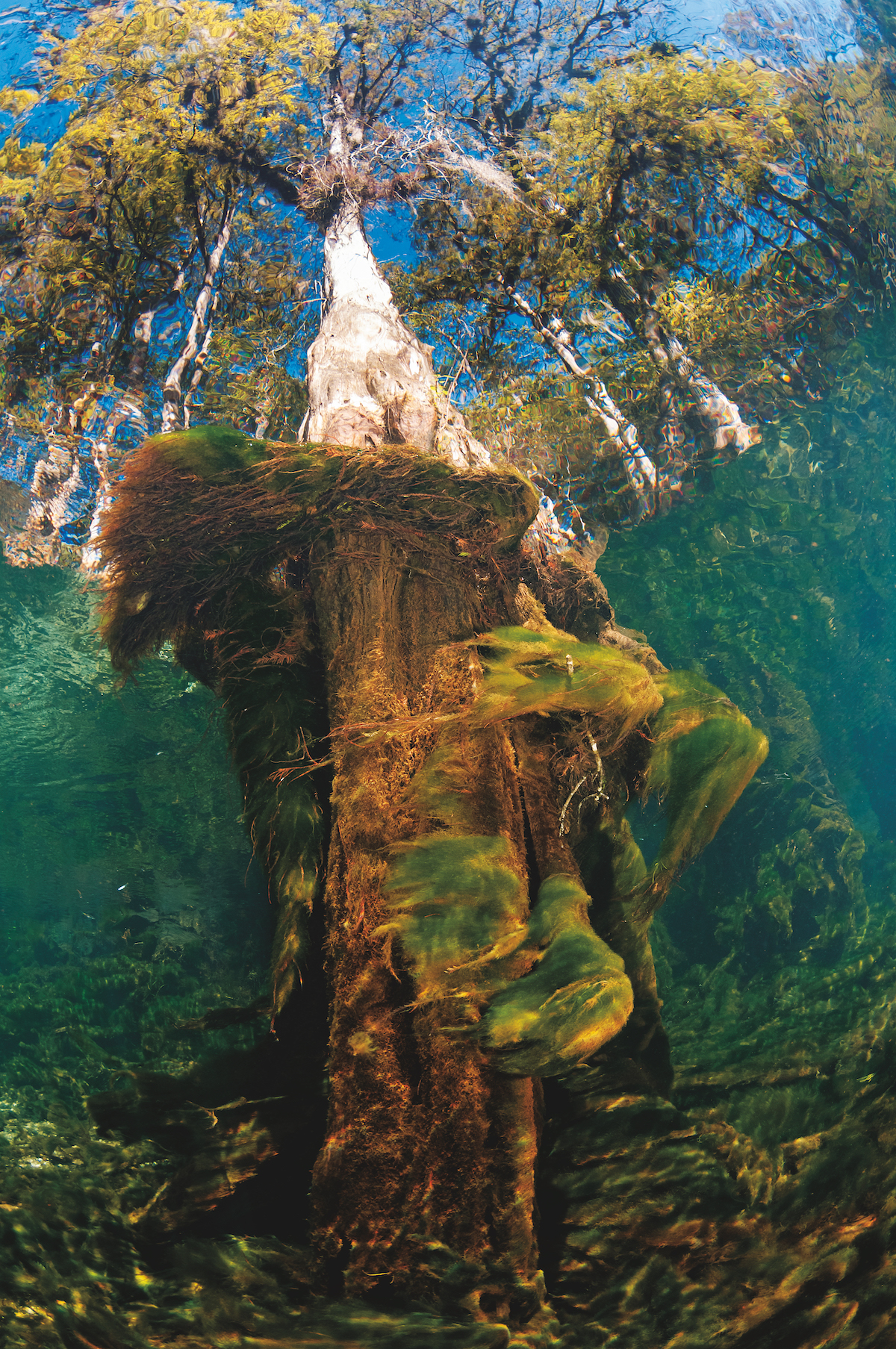
Aside from the simple joy of being immersed in cool fresh water, one of the main attractions of the Manatee Spring basin is following the schools of fingerling catfish and mullet that patrol the headspring's limestone headwall, and possibly venturing into the shallows of the run to search for turtles and bass among the cypress tree roots that line the bank. In winter, manatees may enter the spring to escape the colder water of the nearby Suwannee River, and if they reach the headspring, divers are not allowed to enter the water.
Just a couple hundred feet from the spring basin is the sinkhole known as Catfish Sink. Were it not for the sturdy stairs leading down to the water's edge, you might not guess this was a dive site, as its surface is typically covered in an enveloping layer of green duckweed. The plants that make up this layer of ‘pond scum’ are actually beneficial to water quality, as they block sunlight that would otherwise cause rampant algae growth.
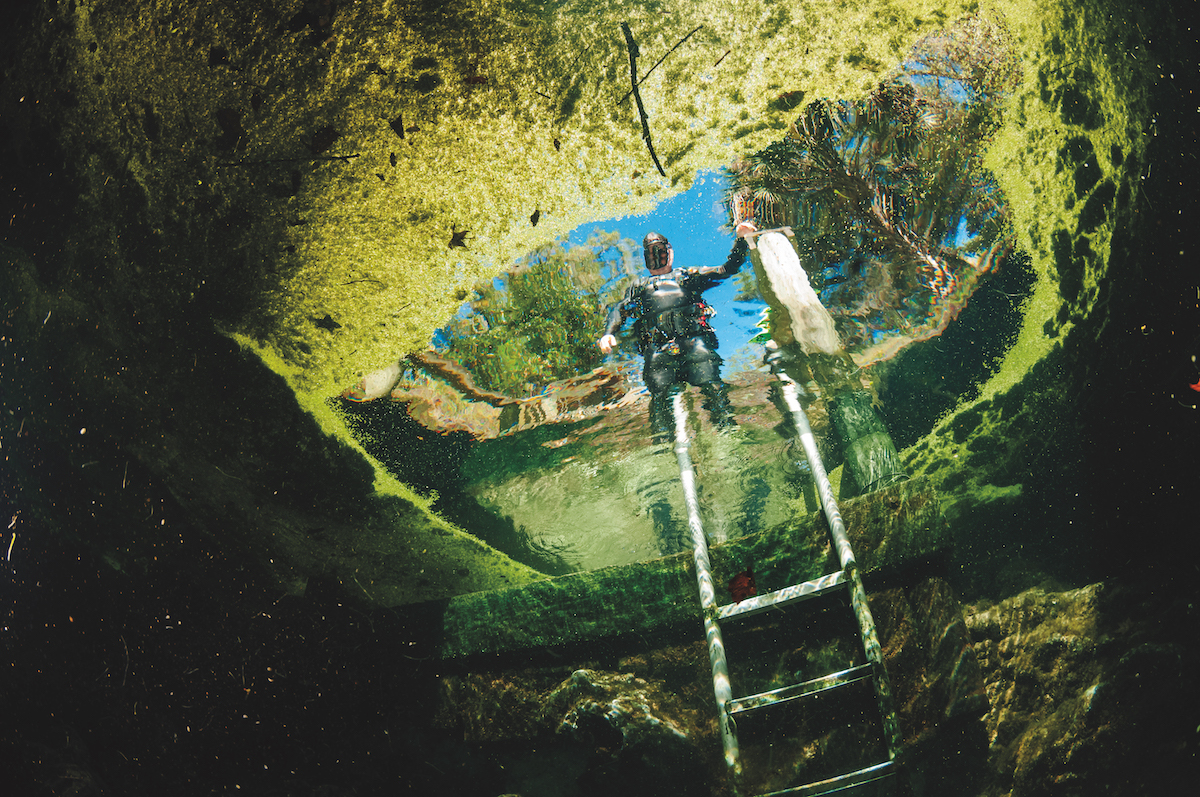
If the green stuff freaks you out, simply swish it away as you enter the water, and you’ll discover a layer of clear water just below. Once you submerge, the bubbles from your regulator will create a hole in the duckweed ceiling as they hit the surface. This phenomenon makes for some very interesting light patterns within the sinkhole. The open-water portion of the sink is a bit more than 100 feet in diameter, and some 50ft deep. Divers who follow the bottom down and to the left will soon find themselves under a limestone ledge, and in a cavern zone that continues down to depths of about 65 feet.
Cavern or cave certifications are required to carry lights, but intrepid open water divers might delve far enough into the shadows to see the faint white glow of the ‘Grim Reaper’ signs that warn of the dark cave passages that lie beyond.
Make Catfish Sink the first dive of the day because it is the deeper site, and because no matter how carefully you clear the duckweed away before surfacing, some of the small green globules will inevitably hitch a ride on your gear. A second dive in the spring basin will wash away the weed, and if you have decent air consumption, you should be able to make both dives on a single tank.
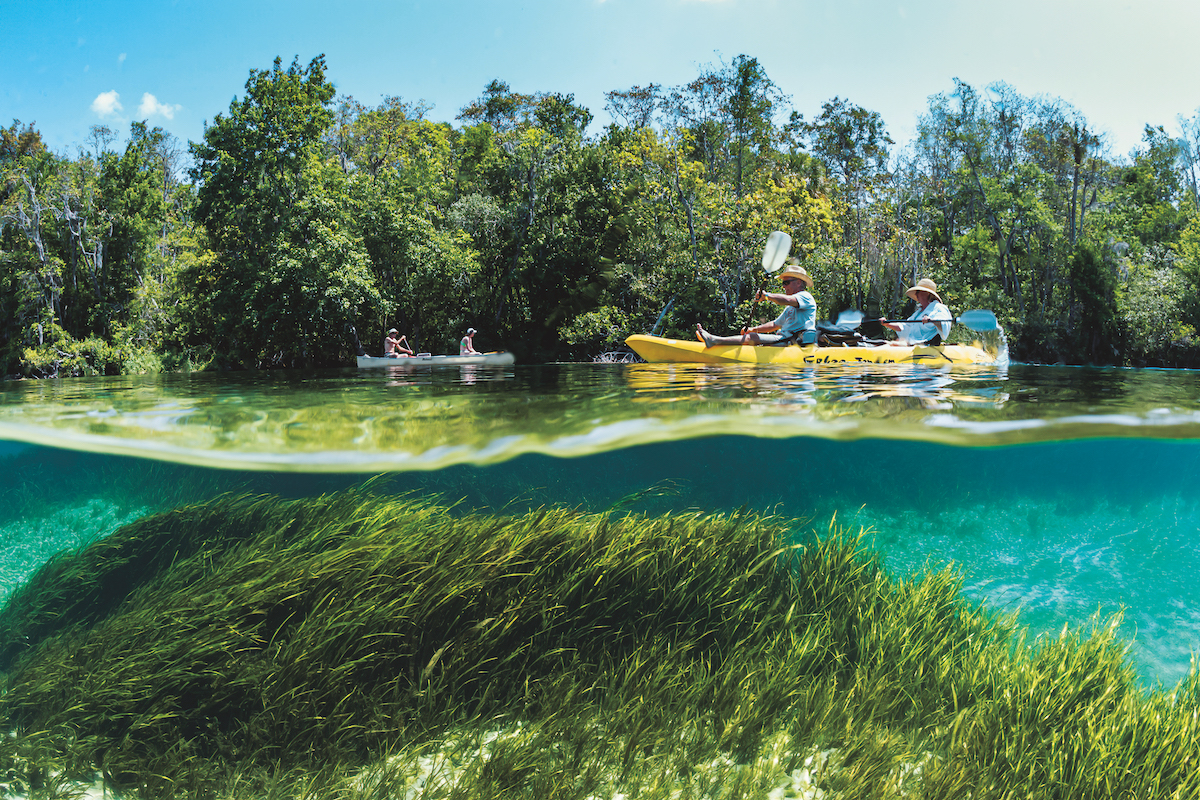
Rainbow River – Luminescent Waters on the Move
Just off Highway 41 and the small town of Dunnellon is one of Florida's true aquatic treasures. Don't miss this on your Florida springs diving trip! Rainbow River is a spring-fed stream that winds its way some 5.7 miles along a sand-bottom channel. In addition to its headspring, Rainbow River's flow is augmented by a two-mile-long progression of clear-water upwellings that issue from crevices in the limestone and boil up from the sand, collectively disgorging some 500 million gallons of fresh water a day.
The underwater clarity of this river has to be seen to be believed. The channel alternates between thick beds of jade-green eelgrass and expanses of white sand punctuated by the occasional limestone rock formation. Adding to the setting’s surreal underwater clarity are dappling rays of light created as sunlight plays through the water’s surface, giving the long blades of the eelgrass a hypnotic undulating tempo set by the river’s steady flow.
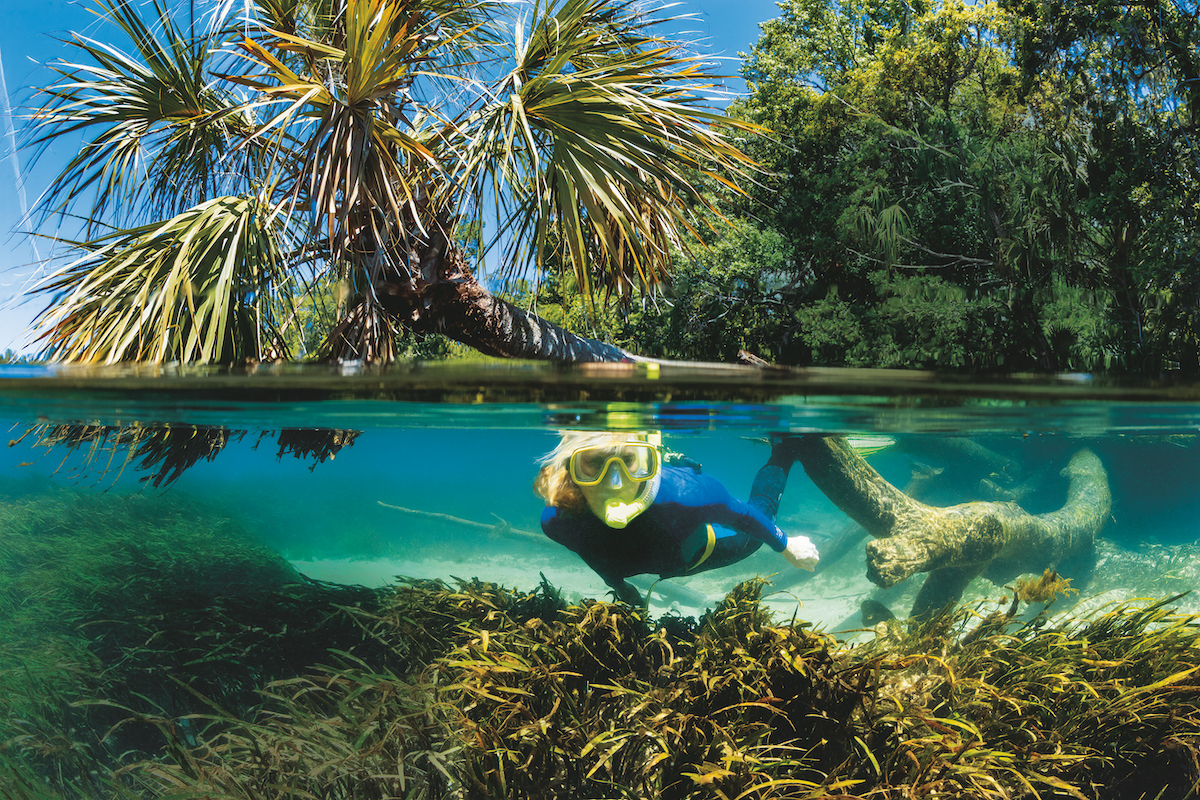
Once accustomed to the view, you'll start to notice the wildlife. While gar and largemouth bass generally take a slow deliberate flyby, other fish like shell crackers and bream can be seen hovering above nests they have set in the sandy areas between the grass beds. For sightings of bowfin (aka mudfish) and the freshwater turtles lurking among the grass beds, snorkelers will have the advantage over those with more-intrusive scuba gear. You may also be fortunate to see diving birds like cormorants and anhingas chasing fish to a river otter or two at play in the river.
Several water taxi services give snorkelers and divers access to the river and for those with a mind toward independence, there's also K.P. Hole park. Located about a mile downstream of Rainbow River’s headwaters, this county-owned facility offers a small swimming beach, changing rooms, picnic facilities and canoe rentals.
From K.P. Hole, it’s about a mile upstream to the point where you would most want to roll overboard and start a drift dive or snorkel. From that point, you can ride the gentle currents using canoe and a requisite dive flag as your surface markers. Weekends can get busy both under and in the water, and my preference is to go during the middle of the week.
While some might consider using scuba to catch this experience, a more-sublime approach to do the river is on snorkel. While it’s possible to make the one-mile drift in 30 minutes if you swim a bit, I generally take a more leisurely pace stopping to look things over as I work on taking pictures. By the end, after two or more-hours of being in the water I exit feeling pleasantly waterlogged and yet renewed.
“Perhaps the locals ages back were correct when they claimed these springs are the real ‘fountains of youth’.”
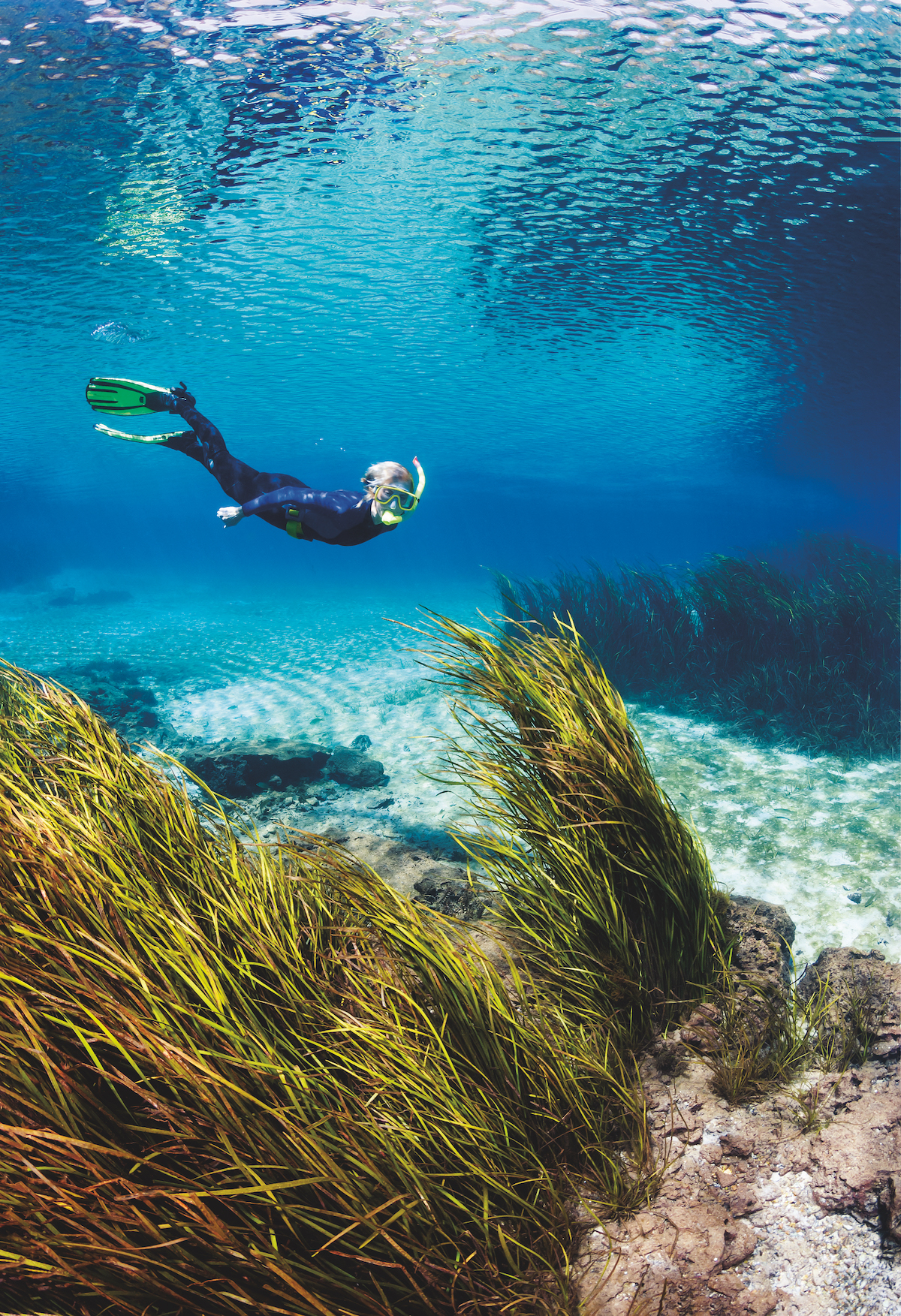
Read the full Destinations Magazine issue 4.
Florida Springs Diving – Did You Know?
The area and hidden spring of Devil’s Den is millions of years old, and in recent years, has become a popular destination for Florida springs diving. People flock from all over the state to test the cave’s waters, which are perpetually 72 degrees F…one of the reasons for its name.
Florida’s caves and caverns have a long and interesting geologic history, beginning 38 million years ago when sea levels were much higher and the southeastern coastal plain of the United States of America was completely submerged by what is now the Atlantic Ocean.
The caves provide habitat for blind cave crayfish, cave salamanders and three species of cave-roosting bats.
Every drop of fresh water flowing out of Florida’s springs originates in a vast subterranean reservoir known as the Florida Aquifer – the water source for more than 60 percent of Florida’s residents, which underlies a region covering more than 100,000 sq miles.
Once named Wekiwa Creek, Blue Spring and Blue Run, archaeological evidence indicates that the crystal-clear waters of the Rainbow River have attracted and sustained human inhabitants for well over 10,000 years.
